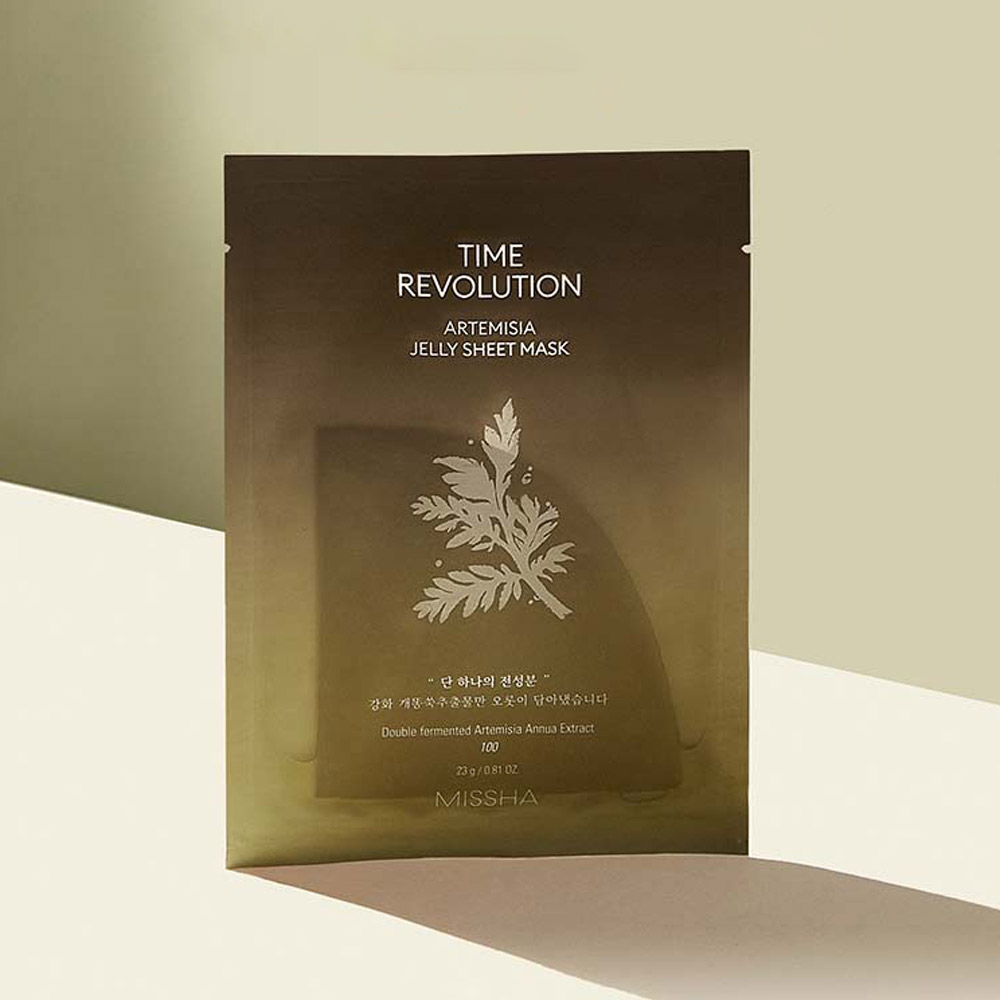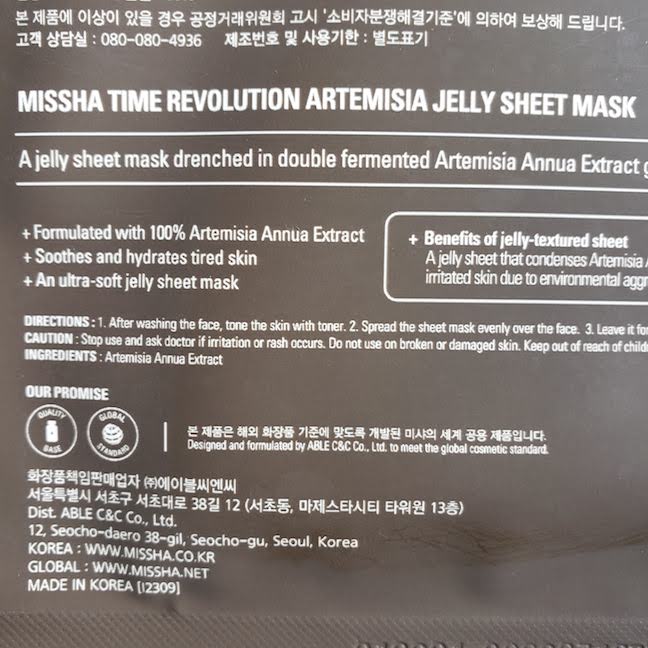You Have to See It to Believe It: Missha Time Revolution Artemisia Jelly Sheet Mask
Before we even get to the actual performance of the mask, we need to address the eye hole elephant in the room (you have to see it to believe it) ...
You know it’s a bad sign when you post a picture of a sheet mask on your Instagram stories and 50% of the responses you get to the picture are variations of “what kind of racist joke is this?!”
But before we get to that part of the story, let’s back up and start from the beginning.
I’ve never had much luck with Missha sheet masks. Years ago, their snail hydrogel mask gave me one of my very rare but very severe skin reactions — I had rough, bumpy, itchy cheeks for a week. I find their Pure Source sheet masks utterly pointless. And yet something about the Time Revolution Artemisia Jelly Sheet Mask intrigued me enough that I offered to review it. So here we are.

The ingredients, er, ingredient
According to the brand, this is a single-ingredient sheet mask. All it contains, according to the English ingredients on the back of the pouch, is 23g of their “double fermented” Artemisia annua extract.

Also known as mugwort, artemisia is trending in K-beauty thanks to its purported anti-inflammatory, antimicrobial, and antioxidant properties. Theoretically, that should make it good for calming redness and irritation, as well as for fending off wrinkle-accelerating free radical damage. Fermentation, meanwhile, breaks down compounds into smaller and theoretically more bioavailable fragments, which may help skin get the most use out of them. Theoretically.
The lack of preservatives in this single-item ingredient list bothers me. I like my preservatives, as I’ve written before. According to my fellow Beautytap writer Sheryll Donerson, however, the trendy single-ingredient artemisia products on the market now aren’t preservative-free. In her article on mugwort, Sheryll wrote that brands use “heat and cooling technologies to extract 100% of the extract from a solution of water and preservatives and all that good stuff.” So … I guess that’s … OK.
The sheet mask
The proof is in the (hopefully mold-free) pudding, so I opened up the first of several of these masks that I’ve used to write this review. I had an immediate and visceral WTF moment. Because LOOK at this mask.

I grew up in a medium-sized Midwestern town where Asians were a very, very, very small minority. In elementary school, other kids routinely mocked me by pulling their eyes back into slanted slits. This mask reminded me of those faces. Therefore, I find the cut of this mask mildly upsetting.
I also find it utterly bewildering, because, honestly, Missha? You are a Korean company. Staffed by Koreans. You know that not all Asians have this particular eye shape and size. In fact, I’d guess that most Asians don’t. So why is this mask cut like this? WHY? How many soju-fueled company dinners did it take to decide that this mask cut would be a good idea? I DON’T UNDERSTAND!
Whatever. Maybe it’s better on.

Oh. No. It isn’t.
Fighting the urge to rip the mask off and throw it straight in the trash in a rage, I got out my sheet mask scissors and carefully cut both the other and inner corners of those eye holes so that I could fold back some of the material that was poking me in the eyeballs. Normally I don’t mind having to make a few snips to a mask to make it fit, but with this mask, I hated doing it. It wouldn’t be necessary if they hadn’t thought it would be a great idea to make a mask with eye holes like a racist joke.

By the way, don’t let the “jelly” in the mask name fool you. This isn’t a hydrogel mask. The essence isn’t thick and jelly-like, either. Instead, it is, according to the package, “a jelly sheet.”

Personally, I wouldn’t call it that. The sheet is indeed strange. It’s a soft, floppy, thick but stretchy material that does feel quite puffed up with essence, but it isn’t “jelly.” The essence, meanwhile, is thin and scentless. This is not at all what I imagine when I imagine a jelly mask.
The results
The mask stayed moist on me for about 30 minutes, which is less than I like but frankly more than I expected, given that it didn’t feel particularly moist in the first place when I applied it. The results were … OK. It hydrated about as well as any budget sheet mask might and left my skin slightly calmer than it was when I first applied the mask. It was just OK.
The sad, disappointing OK-ness of this mask serves as a good example of why I’m pretty iffy about single-ingredient products. The concept sounds exciting. The extracts are the fun stuff, right? Why not just get all of the fun stuff and none of the boring “filler”? Well, this is why. We can have no idea of the actual potency of any extract used in any product. For all we know, the “extract” used here could have been made by putting two sad mugwort leaves in a vat of water.
And a lot of those other, “boring,” “filler” ingredients add extra value to the overall product. A sheet mask without humectants like glycerin or hyaluronic acid is a sheet mask that won’t plump skin as well or as lastingly as one with extra humectants. Not to mention any other soothing or brightening or texture-softening ingredients commonly found in other masks. When you rely on one singular ingredient for all your results, mediocre results shouldn’t come as a surprise.

I really wanted to like this mask, simply because I always want to find new masks to like. Unfortunately, it wasn’t meant to be. Even if the eye holes hadn’t been an issue, the lack of notable effects would be.
Of course, I’m writing this from the perspective of my own individual skin, which is normal leaning towards dry. My fellow writer Leo Louie will be reviewing this mask from his perspective, as an oily skin haver.
Have you tried the Missha Artemisia Jelly Sheet Mask? What did you think? And why do you think they decided to make this mask with that particular eye shape?
All photos courtesy of the author.
Loading...